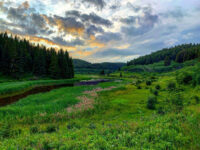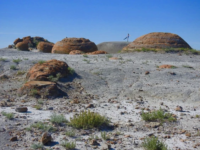Milk River drop structures won’t be replaced until late summer
By Jensen, Randy on June 13, 2020.
Tim Kalinowski
Lethbridge Herald
tkalinowski@lethbridgeherald.com
There is good news and bad news when it comes to water issues on the Milk River this summer. The good news is the Montana-based Joint Board of Control will be replacing the failed Drop 5 and failing Drop 2 structures on the St. Mary River Diversion project this summer. The bad news is it will not be done in time to help Milk River irrigators on either side of the border who rely on St. Mary River Diversion water for farming this season.
“We jointly with the Joint Board of Control, which is comprised of the eight irrigation districts on the Milk River Project and the Montana Natural Resources and Conservation, have all been on site doing an engineering examination of Drop Structure Number 5,” explains Steve Davies, area manager with the U.S. Bureau of Reclamation in Montana. “The team looked at temporary measures as well as a permanent replacement of Drop Structure Number 5, and for a lot of reasons the Joint Board’s decision is to not pursue temporary alternatives.”
The Drop 5 structure near Whiskey Gap on the Montana side of the border failed on May 17, essentially shutting off all diversion water to the Milk River and putting communities like the Town of Milk River and the Village of Coutts into potential water crisis.
Davies said the additional costs and possible structural integrity issues associated with a temporary diversion made it unfeasible to construct, particularly since the Drop 2 Structure near Immigration Gap about five miles west of Drop 5 is also in desperate need of replacement.
“A second important decision in addition to proceeding with permanent repairs (at Drop 5) is proceeding with Drop Structure Number 2 replacement simultaneously,” explains Davies. “Drop Structure Number 2 is also deemed to be at high risk of imminent failure.”
Davies says the replacement of both structures will not be completed until late summer at the earliest. His office and the Joint Board of Control continues to consult with water users on both sides of the border, he says.
“We are in discussions with the accrediting officers for the United States and Canada,” Davies states. “We’re meeting this week to identify the potential impact to Canada. Canada has the right to natural flow on the Milk River, but not to the St. Mary water we can bring through the canal. That is Milk River Project water, but it is our understanding there are impacts in Canada from the reduced river levels. Access to water is more difficult by having a lower stage in the river, and so we are talking with Canada about that.”
Davies expects construction on both drop structures to commence in the next few weeks on an “emergency basis.” A construction firm out of Great Falls has already been contracted to do the work, he confirms.
Tim Romanow, executive director of the Milk River Watershed Council, says his stakeholders are focusing on the silver lining here, and preparing for a potentially dry summer ahead.
“It is very unfortunate that we won’t likely have any additional water running from the St. Mary to the Milk for the rest of the season,” he states, “but the benefit will definitely be a bit of a silver lining for the St. Mary River Irrigation District and the southern tributaries to the Oldman River because there should be excess water throughout the summer this year to hold our other reservoir levels in other irrigation districts up a lot higher than they would have been with regular use.”
Another silver lining is the Drop 5 and Drop 2 structures will both be replaced at the end of it all, says Romanow, something Milk River water users have been advocating for decades.
“It is really good news because Drop 2 was in a position where everyone thought it was likely to be the first one to fail, and instead of just repairing Drop 5 and hoping for the best with the rest of the system it is good they are going to be able to get in and do the engineering to get both structures done at the same time,” he states.
Kevin Reese of the Milk River Water Users Association is one of the farmers heavily affected by the potential loss of irrigation water this summer. Natural flow is still good enough at the moment to get some sprinkling done thanks to recent rains, he says, but the worries will come in July.
“It’s really going to hurt us quite a bit,” says Reese, who has about 800 acres under irrigation. “Crops will be quite a bit smaller than we would normally get, and no second or third cuts of hay, and that type of thing.
“We have had at least three years now of really dry times,” he adds, “and that has been tough on our dryland crops. It has been really harsh. Irrigation has been a lifesaver for our operation. It has made it so we can survive, have crops and have enough feed for our cattle. All we can do is hope we have a few timely rains to help carry the crop, and that we can get through the season and cover our expenses until next season.”
Although likely to face some hardship this summer without timely rains, Reese is happy someone is finally taking action south of the border on these century-old drop structures after years of neglect.
“Those are old structures, and we have known for at least 20 years they needed to be repaired or rebuilt,” he explains. “Somehow that was procrastinated on until there was a crisis.”
He hopes this crisis also drives home to government officials on this side of the border the need to get moving on creating additional storage capacity infrastructure on the Milk River, something he and all water users in the region have also been advocating for decades.
Follow @TimKalHerald on Twitter
24-23




